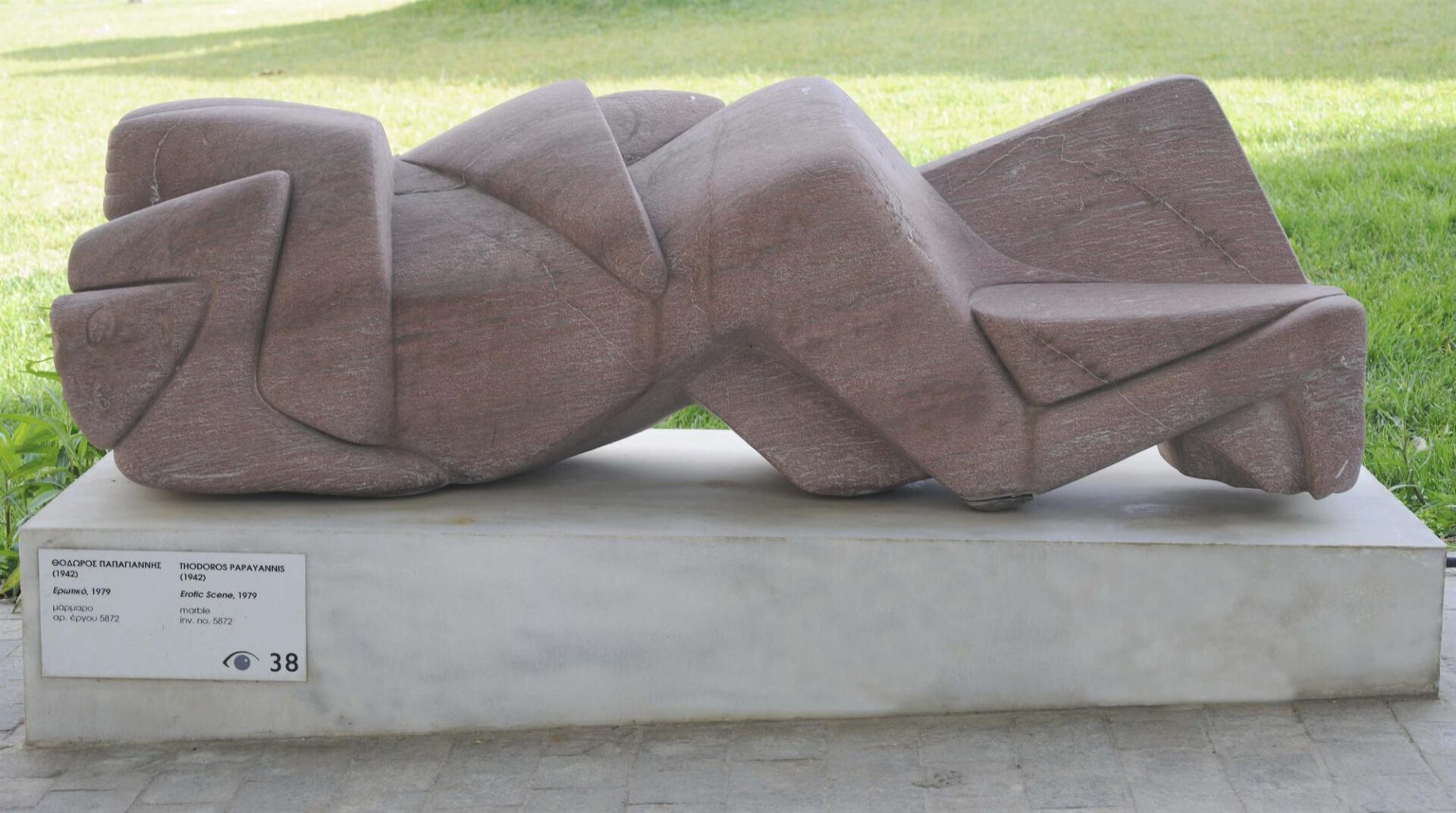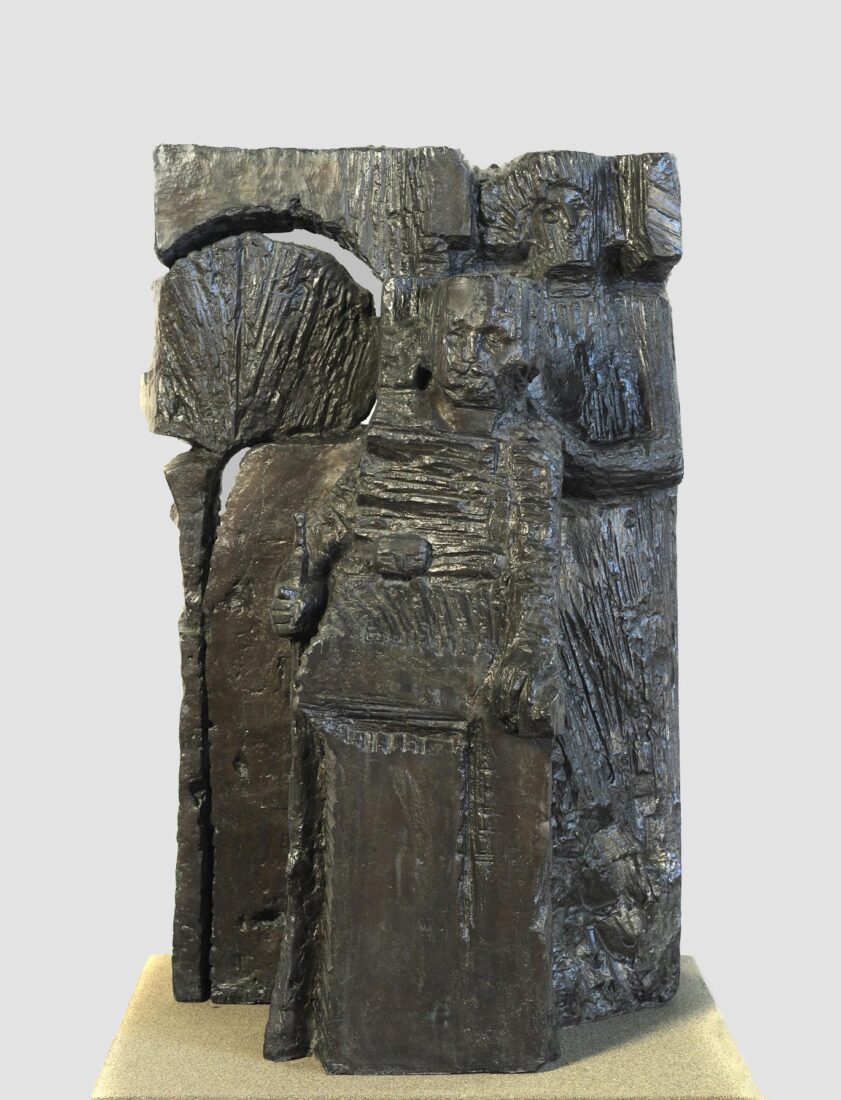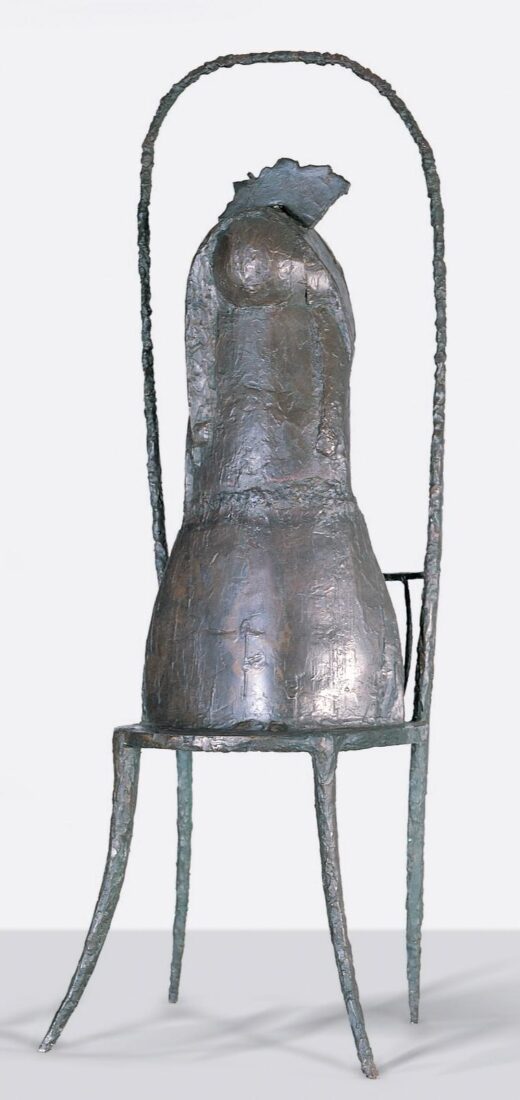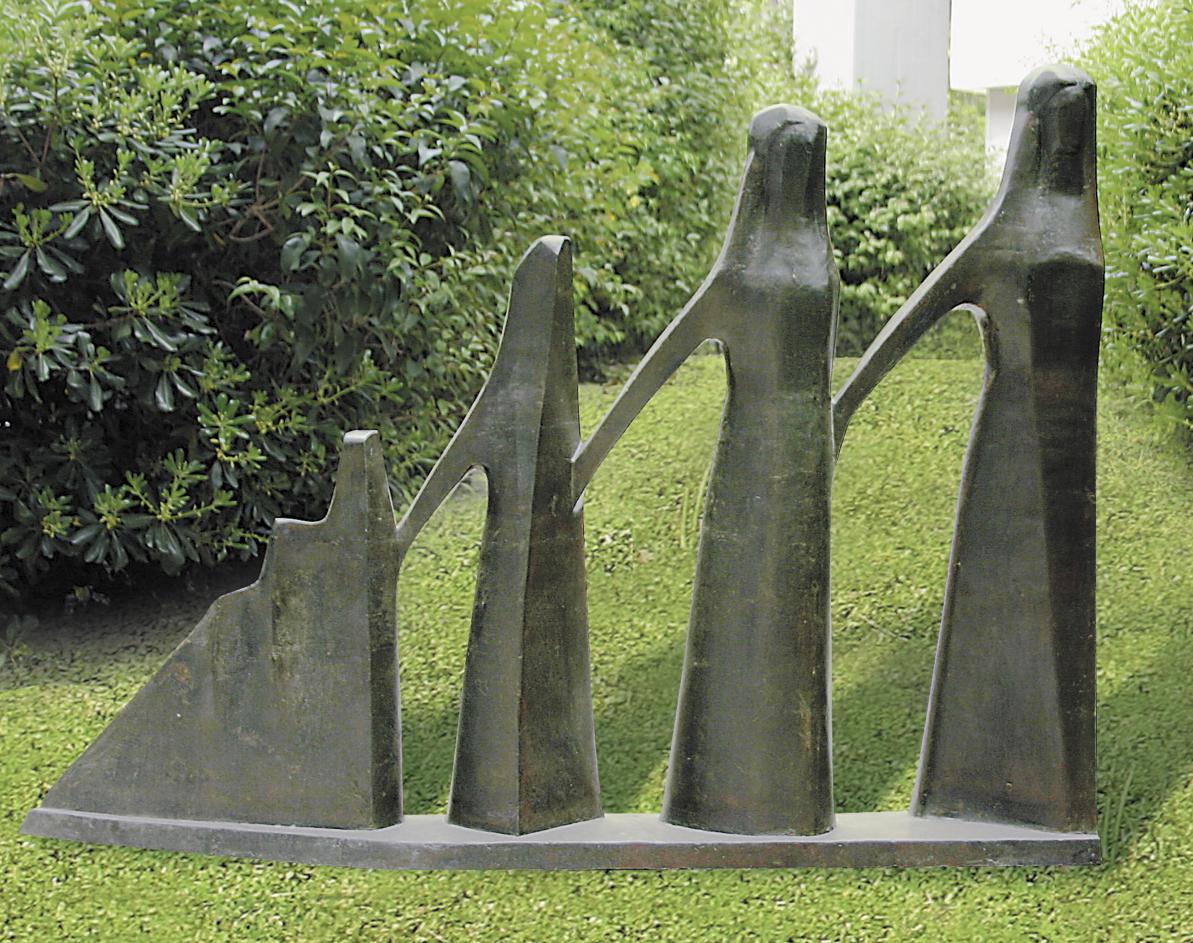The full-length male figure, heir to the ancient Kouros, dominates Joannis Avramidis’ oeuvre. However, his is a figure that is stripped of every descriptive detail. Schematized, it stands upright, self-contained, imposing and static, like an ancient column.
The solitary figure-standard, as of 1959, constituted the core of his group compositions. The figures create a unit and frequently result from the revolving of the ancient figure around its axis. In this manner, Avramidis conveyed the idea of the ancient Greek “Polis” (City-State) in his sculpture of the same title. The repetition of the ancient figure nine times creates a compact group of identically-sized figures with like features. The piece thus personifies the idea of a community in which all its citizens are equal.
Manolis Tzombanakis focused on the human figure right from the start of his career. At the same time, he preferred to express himself through representation, but with a non-figurative bent, forming his own personal style from early on. His subjects, taken from everyday life, history or myth, often have an allegorical content or constitute a means of protest on a social or political level.
The compositions with horses or mounted figures, to which “Bucephalus” belongs, occupied him from 1972 to 1979 and despite the fact they can be connected to Greek tradition, in reality they were inspired by the Uprising at the National Technical University of Athens in 1973, against the dictatorship. Tzombanakis wanted to express the burden this dramatic event in recent Greek history placed on him as well as his protest against tyranny of any kind by using symbolic elements from other periods, but with clear allusions. “Bucephalus”, the unruly horse of Alexander the Great that only he managed to tame, is built of geometric volumes and is rendered in an intense and daring movement, expressing the momentary, an element which characterizes the artist’s compositions during that period, and echoes the dynamic movement hidden in the works of the Futurists and especially those by Umberto Boccioni.
Michalis Tombros pioneered in the dissemination of avant-garde movements in Modern Greek art. From 1925 to 1928 he lived and worked in Paris, but had already visited the French capital three times. The last three years of his stay were a turning point in shaping his style, which is characterised by a prominent duality: on the one hand, figurative (female figures), clearly influenced by the sculpture of Aristide Maillol, and public monuments in the academic style, and, on the other hand, cubist or surrealistic compositions from the late 1920s on. He focused more consistently to surrealistic works, however, since around 1950. Thus, works such as “Elf”, revolve around, or combine, organic and vegetable motifs with geometric patterns and outlandish creatures, with references to the sculpture of Alexander Archipenko and Ossip Zadkine.
Gabriela Simossi worked in the framework of representational art, but in a manner which served to bring inspirations with a strong surrealistic and at the same time poetic character to fruition, based in large part on memories derived from ancient Greek sculpture. The mutilated statues for the most part became the motivation to produce her own fragmentary compositions, which have an enigmatic style and are emotionally charged, most likely as the result of her own personal experiences. The whiteness of plaster, furthermore, of a material she makes frequent use of, contributes to an impression of silence and confinement in her work, qualities that can be recognized in a considerable number of her works.
In “The Eraser” the dominant element is the feeling of non-existence. A female face, melancholic but at the same time resolved, a type repeated in rather a large number of her works, is projected in relief within an indeterminate environment and is seen disappearing slowly under the movement of an eraser which leaves its traces on the surface in a symbolic gesture of deleting the being.
Aspassia Papadoperaki is a sculptor focused on the human figure. Although she did not reject figurative represantation, she adopted strong schematization based on geometric shapes. Also a student, among others, of Dimitris Kalamaras, she followed her teacher’s precepts on order, harmony, measure and whatever was based on the law of number, creating tectonic compositions formed of geometric shapes. The views of Le Corbusier pricked her interest as well and expanded her already active speculations, leading her to further examine and study the figure in regard to measure and proportion.
“Couple with Horse” is a composition which expresses clearly the sculptor’s principles in regard to the rendering of forms which arise from careful calculation and measurement and is based on geometric shapes.
Thodoros Papayannis made the human figure practically his exclusive subject, but liberated from any trite naturalistic stylization. His knowledge of ancient Greek civilization and the broader Mediterranean region, Greek folk tradition and his post-graduate studies in Paris later on, nourished, by the stimuli they offered him, the formation of his style.
The image of the couple, in a standing or seated pose, but locked in an erotic embrace as well, was from early on one of his particularly favored subjects for sculpture. The erotic embrace was the spark for the creation of a series of compositions such as “Erotic Scene”, where the figures of the couple are entangled and thus tectonic compositions are created, formed of geometric volumes. These compositions echo the cubist sculpture of Henri Laurens, Ossip Zadkine and Jacques Lipschitz while at the same time borrowing elements from images of nature taken from old memories: “…I often recognize in my erotic compositions specific landscapes from the volumes of the mountains I drew at one time…I see the female body being transformed into an adventure, beckoning collection of hills and valleys…” he characteristically writes, describing his work.
The work of Thymios Panourgias revolves around the human figure, sometimes left free in space and other times incorporated into a schematic background which suggests a natural landscape. Conversant with the traditional manner of depiction, but also contemporary trends, he works with stone, marble and metal and creates, among others, abstract compositions made of compact and heavy geometric volumes with a roughly worked surface.
The “Composition” is a characteristic work in which the seated man and the standing woman project outward in a high relief from the compact rectangular volume which surrounds them and constitutes the background of the composition. This background, which makes up a schematic suggestion of a landscape with a tree, sets off the space and creates a specific environment, in which the two figures are incorporated.
The human being – as form or idea – is the focus of Vangelis Moustakas’ sculpture. His subjects, inspired by Greek mythology, Greek or ecumenical reality, as well as his own personal experiences, is a protest against pain, violence and oppression. Ancient Greek models are combined with the trends found in modern art – fragmentation, non-figurative rendition, surrealistic atmosphere – while the light traverses the surfaces by means of alternations of the empty and full spaces of the composition.
The subject of “Nike” (“Victory”) has repeatedly occupied him, as a triumphal response of the human being to pain and death. The “Victory” exhibited at the National Glyptotheque is a composition with five fragmentary figures, with the figure of Nike commanding the right side. Freely exploiting the ancient prototype of the “Nike of Paionios”, it was made in 1967 in recollection of a specific historical event: the victory of the Israelis in the Six Day War of June 1967. For Vangelis Moustakas this event had a particular resonance, as he considers the Jewish people to embody par excellence the pain and tribulation suffered by all humankind. So this Victory expresses the end of centuries of terror.
Giorgos Lambrou’s first sculptures, done with wire, were an extension of his quests in drawing. During his career his forms have acquired volume, but have retained their spareness and the tendency toward the schematic, which indeed characterizes all his work. At the same time, they would come to constitute the means he uses to express his critique of the mass homogenization of contemporary society. Thus, in one of his series of compositions, to which belongs the work “Little Men Tightly Clasped III”, the focus would be on the human figure. Mass homogenization and the subsequent levelling, insecurity, alienation, and inner isolation, are expressed by means of three or more human figures which stick out of a compact volume. They are without arms or legs and, by extension, without the ability for free action or escape and end up by being identical, mere schematic suggestions of heads without any individual characteristics. The asphyxiating atmosphere is intensified by the schematization and the rhythmically repeated grooving of the surface, which creates light and dark zones and gives the impression of real bonds.
Until the late 1940s, the human figure and the figurative approach all but monopolised the attention of Greek sculptors. Nevertheless, although some remained committed to the academic approach, or to the post-Rodin French school style, others increasingly turned towards more simplified and abstract shapes, each shaping his personal style through various influences by the European avant-garde. Thus, they approached the human figure with a new perception, which led to a diversity of treatments: simplified, or completely stylised and suggestive, fragmentary, or expressionistic.
In the National Gallery collection, the work that marks the shift towards the abstracted, allusive rendition of the human figure, in what is in fact one of the most “extreme” examples, while also ushering in the 1950s, is “Two Girls” by Lazaros Lameras. Reminiscent of Cycladic figurines, the two girls are upright, stylised and almost two-dimensional, retaining only the basic elements of female body forms, reaching the limits of abstraction.
Centered on the human being, Kostas Klouvatos started out with a realistic but simplified rendering of his figure and then became gradually more non-figurative till he achieved nearly completely abstract shapes. Inspired by the figurines from the geometric period or folk art, he aspires to express everyday human situations, passions, problems and struggles, in the framework of social speculation.
The work exhibited at the National Glyptotheque belongs to a series of compositions from the Sixties which aspire to project the essence of the content, adopting an expressionistic style. This tendency is obvious both in the manner of rendering the figures and in the manipulation of the surface of the material which the sculptor deliberately leaves rough and unworked, so that it creates the impression of rust, giving even greater intensity to his compositions’ content.
Spyros Katapodis was a sculptor concerned with the human figure, since his subjects always revolved around the human being or referred symbolically to situations related to human life. With a tendency toward abstraction, he worked with elements from cubism, constructivism and even surrealism, giving form in his compositions to whatever moved him or made him dream.
Two of the most common subjects he addressed in his sculpture, the chair and the human figure, are combined in “Aretoussa”. The stressed, compact, but concise rendering of volume of the girl’s body, who appears to be set like a doll on the chair, is in contrast to the finely-made chair, a recollection of older furniture, which takes the form of a swing as the back frames the body of the child. The composition is unquestionably emotionally charged, perhaps by the childhood or adolescent experiences of the artist, something true of quite a number of his works, thus revealing nostalgia for the innocence of childhood.
Kostas Koulentianos was one of the most important representatives of abstraction in Greek sculpture. After completing his studies at the Athens School of Fine Arts, he left for Paris in 1945 as part of the first post-war group of scholarship artists funded by the French government. France then became his permanent place of residence until his death.
His meeting with Henri Laurens in 1947 was definitive for his artistic career and contributed even more to the rejection of the academic precepts he had been taught but which he had already begun to doubt. At the same time he abandoned the traditional materials, clay, plaster and bronze, and turned to lead and, later, iron. The influence of Laurens can be easily spotted in the works from the Fifties, in which Koulentianos was still working in a figurative framework, but with a strong abstractive tendency, his subjects still revolving around the human figure. In these works, such as the “Sea Victory”, curved organic forms are the rule, along with the movement and succession of empty and full spaces which reveal from early on the artist’s consistent speculations in regards with space, light and volume.
The fragmentary, stylised and abstract human figure, with references to Constantin Brancusi’s style, or more frequently, Hans Arp, is at the centre of Kyriakos Kambadakis’s sculpture.
In 1976, he began his series of torsos, mainly in wood, of which “Torso III” is one; fluid, curvilinear forms that set the light gliding across the surface, reflecting the texture of the wood and striking an ethereal effect. Meanwhile, the stillness is dispelled by a latent movement, conveyed by the twisting of the torso, the tightening of the shoulders, or the tilt of the head, which betray inner passion, or emotion, stirred by the existential angst that the artist sought to express in the majority of his works.
Giorgos Zongolopoulos worked with figurative depiction centered on the human being for a considerable period of time before moving on to completely abstract compositions. The realistic portraits he did, by and large before 1940, were succeeded by full-bodied figures with a steadily growing intensification of the simplified and schematic forms, particularly apparent in the Fifties.
The “Dance of Zalongo” was made at the beginning of the Fifties and is a study for the large white stone monument which was erected in Zalongo in 1961, in remembrance of the heroic act of the women of Souli, who, while dancing, fell down a precipice in order to avoid to get captured by the Turks. The composition aimed at the elevation of the monument so it would be visible from a great distance as well as its harmonization with the wild and imposing landscape. Its outline formed a triangle which contains four women holding each other by the hand. Rendered with exceptional austerity, these women grow gradually smaller in size and become more and more schematic, till the final one is little more than a compact volume, completely abstract. This successive development of the figures, which were erected as if they were otherworldly visions, lends the work rhythm and grandeur, while at the same time they harmoniously combine the empty with the full, an element that would particularly occupy Zongolopoulos in his later work as well.
A student of Antoine Bourdelle, Bella Raftopoulou fashioned her own style combining the doctrines received from her teacher, as well as a variety of influences taken from both traditional and contemporary sources. Her favorite subjects were human figure, for the main part, as well as animals or birds, on a more limited scale, works of large dimensions, which were carved directly into stone. Initially working in a realistic manner, her style became gradually more abstract, the figures more schematic and the compositions tectonic based on geometric and organic elements and rendered with flat curved surfaces. Furthermore, the empty space in some compositions contributes to the creation of the overall impression.
The “Couple”, one of her last works, is characteristic of this point of view. Obviously inspired by the “Kiss” by Constantin Brancusi, it is built on three roughly worked pieces of stone, which are interrupted only by the empty spaces between the legs, the body and the faces of the figures. Rendered with an especially emphatic form of schematization, the two figures create the impression of complete union, while the differentiation of the female from the male body is expressed in a completely schematic way, as the middle part is curved on one side to suggest the curve of the female body.
An artist faithful to the study of nature and an admirer of the art of the Renaissance, Dimitris Kalamaras always placed the focus of his sculpture on the human figure. Without ever distancing himself completely from representational imagery, he moved towards abstraction, eventually arriving at an architecturalized sculpture based on geometric volumes. This end product was the natural conclusion of his firm belief in order, harmony, symmetry and whatever had its basis in the law of numbers.
The “Head of Alexander the Great” came from a study of an equestrian statue that was to be installed in the northern city of Florina, and was part of a subject that particularly concerned him – that of the “horse and rider.” Kalamaras began researching this theme while still a student in Italy, when he measured and drew the equestrian statues of “Marcus Aurelius”, the “Colleoni“ by Andrea Verocchio and the “Gattamelata” by Donatello. The equestrian statue of Alexander (1958-1993) sums up all his concerns regarding the rendering of forms. It is a static work, imposing and rigidly frontal, built of parallelograms and cubes and based on the archetypal shape of the cross, on symmetry and on precise measurements.
Giorgos Kalakallas fashioned his personal style combining elements taken from differing stylistic trends and the tradition with the avant garde. Employing a broad thematic field, he makes use of a figurative manner for works that are commissioned and a non-figurative or a completely abstract form of expression for his own free compositions, taking advantage of the possibilities of the various materials.
“Harlequin” is an abstract composition, but at the same time retains certain characteristic elements from the traditional manner of depicting the figure of the jester. Thus, the human figure is rendered in a suggestive way, while the whole is based on dynamic curved volumes and angular geometric shapes which penetrate space, creating a composition which imposes itself, while at the same time it converses with the empty spaces which are created by the distribution of the volumes.
Dimitris Armakolas has made the human figure the focal point of his creation. Though his interest was in abstract expression in the beginning, during his career he has gone back to figurative depiction, where the nude body continues to be the main point of reference.
The subject of the fragmentary, nude, female body in an attitude of apotheosis, such as the “Emerging Venus II”, has been the center of many of his compositions. The nude female figure with the sensual expression and the smooth skin is seen emerging mysteriously amid unworked volumes, while at the same time inviting the viewer to supplement with his own imagination the parts that are missing, in an endeavor to carry on a conversation with him.
Ioannis Avramidis was born in Vatum, Russia. In 1943 he settled in Vienna, where for a number of years he was a professor and Director of the Academy of Fine Arts.
The full-length male figure, heir to the ancient Kouros, dominates his oeuvre.
In 1967, Avramidis began a series of figures that he called “Bandfiguren” – i.e. Figures in Bands or rows. He also introduced movement into these compositions. “Walker” is the prelude to this new concept. Maintaining the frontality and using the ancient Kouros as a prototype, Avramidis concentrated his treatment exclusively on the schematized depiction of the figure’s legs. Thus he created a thoroughly abstract composition, yet one that despite the omission of the head, body and arms, remains totally clear in its concept.

























